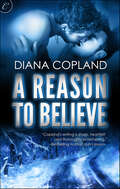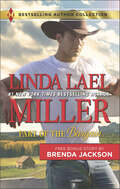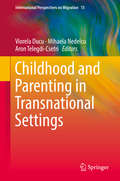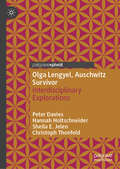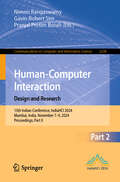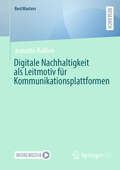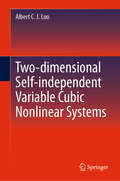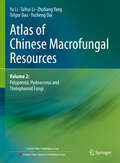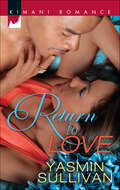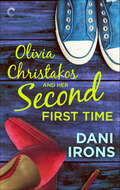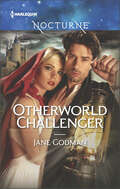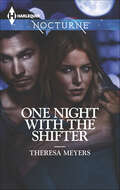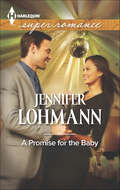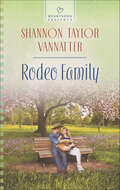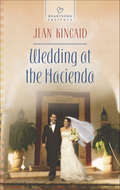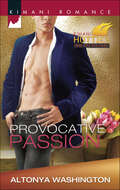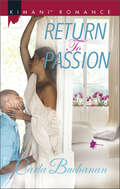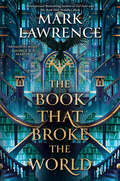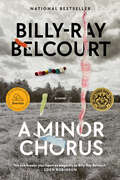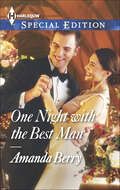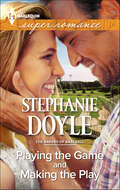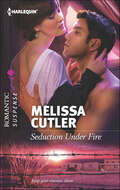- Table View
- List View
A Reason to Believe
by Diana CoplandDetective Matthew Bennett doesn't believe in ghosts. So when the spirit of a murdered child leads him to her body, he's shaken to the core-and taken off the case. Unable to explain his vision, or to let go of the investigation, Matthew turns to renowned medium Kiernan Fitzpatrick. Though he has doubts about Kiernan's claims to communicate with the dead, Matt is nevertheless drawn to the handsome psychic, who awakens feelings he thought were long-buried.Haunted by the lingering spirit of the little girl, Kiernan is compelled to aid in the search for her killer. The chance to get closer to the enigmatic Matt is an unexpected bonus. Although Kiernan's been betrayed by people who turned out to be more interested in his fame than in himself, with Matt he's willing to risk his heart. As the two men grow closer, Kiernan helps Matt rediscover that life offers no guarantees-but love offers a reason to believe...81,000 words
Part of the Bargain
by Linda Lael MillerNO PLACE LIKE HOMEAfter a searing tragedy, Libby Kincaid just wants to go home. But the Circle Bar B ranch isn’t the haven she expects it to be. Malicious rumors about Libby are circulating through the ranch, and worse, her lifelong opponent, rancher Jess Barlowe, believes them. The cowboy is as sexy and rugged as ever…but now he’s promised to keep a very close eye on her…The more time Jess spends with Libby, the harder it is to resist her. He can’t get her out of his mind, but his doubts linger. Are the rumors true? Is he the man she really wants? And in the end, can a proud cowboy like Jess love a woman he can’t completely trust?FREE BONUS STORY INCLUDED IN THIS VOLUME!A Wife for a Westmoreland by New York Times bestselling author Brenda JacksonDerringer Westmoreland is haunted by memories of a woman whose face he cannot recall. When he finally traces his mystery woman, Lucia Conyers, she’s less than impressed with his charms. For the first time in his life, if he wants to win a woman’s heart, he’ll have to risk his own.
Childhood and Parenting in Transnational Settings (International Perspectives on Migration #15)
by Viorela Ducu Mihaela Nedelcu Aron Telegdi-CsetriThis book describes children and youth on the one hand and parents on the other within the newly configured worlds of transnational families. Focus is put on children born abroad, brought up abroad, studying abroad, in vulnerable situations, and/or subject of trafficking. The book also provides insight into the delicate relationships that arise with parents, such as migrant parents who are parenting from a distance, elderly parents supporting migrant adult children, fathers left behind by migration, and Eastern-European parents in Nordic countries. It also touches upon life strategies developed in response to migration situations, such as the transfer of care, transnational (virtual) communication, common visits (to and from), and the co-presence of family members in each other’s (distant) lives. As such this book provides a wealth of information for researchers, policy makers and all those working in the field of migration and with migrants.The chapter 'Afterword: Gender Practices in Transnational Families' is open access under a CC BY 4.0 license via link.springer.com.
Olga Lengyel, Auschwitz Survivor: Interdisciplinary Explorations
by Peter Davies Sheila E. Jelen Christoph Thonfeld Hannah HoltschneiderThis book arises out of a long series of conversations about one of the most intriguing, but still under-researched, aspects of testimony: how the remembering and telling of an individual Holocaust survivor changes through time, through shifting contexts and with increasing age. It comes at this issue from an interdisciplinary perspective, not with the intention to develop a synthetic method but to explore how different perspectives overlap, conflict with or complement each other. It sets its definition of 'testimony statement' very broadly, treating published texts, video testimonies, and fragmentary statements and publications as of equal interest, without a hierarchy of value. The book focuses on Olga Lengyel (1908-2001). She wrote a memoir about her imprisonment in Auschwitz, first published in French in 1946, which was translated into English with modifications in 1947, and, half a century later, in 1998, she gave video testimony for the USC Shoah Foundation’s Visual History Archive. Her testimony is well known enough to have gained a public profile and to have attracted some scholarly attention, but is not 'canonical'. Her work is internationally known, having been translated and received in a number of languages, and having been an inspiration for William Styron’s bestseller Sophie’s Choice. This book provides a condensed critical resource on Lengyel’s testimonies, addressing matters of historical veracity, of trauma, of gender, of memory, and of genre in the transmission and reception of Holocaust testimonies over time and across cultures.
Human-Computer Interaction. Design and Research: 15th Indian Conference, IndiaHCI 2024, Mumbai, India, November 7–9, 2024, Proceedings, Part II (Communications in Computer and Information Science #2338)
by Nimmi Rangaswamy Gavin Robert Sim Pranjal Protim BorahThis two-volume proceedings, set CCIS 2337-2338, constitutes of the proceedings of 15th Indian Conference on Human-Computer Interaction Design and Research, IndiaHCI 2024, held in Mumbai, India, during November 7–9, 2024. The 30 full papers and 12 short papers included in this volume were carefully reviewed and selected from 235 submissions. These papers belong to various tracks which have been divided between the two volumes as follows: - Part I: Paper Track. Part II: Game Design Track, Student Research Consortium Track; Posters and demos Track; Artworks and installations Track.
Digitale Nachhaltigkeit als Leitmotiv für Kommunikationsplattformen (BestMasters)
by Jeanette KollienDas 21. Jahrhundert bringt zahlreiche sozialökologische Herausforderungen mit sich: Neben Globalisierung und digitaler Revolution, die das menschliche Zusammenleben tiefgreifend beeinflusst haben, ist auch ein weltweites Erstarken rechtspopulistischer Strömungen und eine Verschlechterung der Kriegs- und Konfliktsituation zu beobachten, die wiederum Flucht, Armut und soziale Ungleichheit verstärken. Diese kritischen globalen Veränderungen sind zudem in den Kontext des sechsten Massenaussterbens und eines nicht mehr aufhaltbaren Klimawandels eingebettet - berechtigterweise ist von einer Polykrise die Rede. Das Schlagwort für die Lösung aller Probleme lautet: Nachhaltigkeit. Vor allem Informations- und Kommunikationstechnologien spielen im Kontext globaler Nachhaltigkeit eine immer wichtigere, aber vor allem eine duale Rolle, da sie einerseits ein Treiber negativer Auswirkungen sind und andererseits Grundlage für nachhaltige Entwicklungen sein können. In diesem Buch werden Konzepte für digitale Nachhaltigkeit untersucht und Expert*innen befragt, um konkret die ökologische, ökonomische, soziale und auch informationelle Nachhaltigkeit von Kommunikationsplattformen zu bewerten.
Two-dimensional Self-independent Variable Cubic Nonlinear Systems
by Albert C. LuoThis book, the third of 15 related monographs, presents systematically a theory of self-independent cubic nonlinear systems. Here, at least one vector field is self-cubic, and the other vector field can be constant, self-linear, self-quadratic, or self-cubic. For constant vector fields in this book, the dynamical systems possess 1-dimensional flows, such as source, sink and saddle flows, plus third-order source and sink flows. For self-linear and self-cubic systems discussed, the dynamical systems possess source, sink and saddle equilibriums, saddle-source and saddle-sink, third-order sink and source (i.e, (3rd SI:SI)-sink and (3rdSO:SO)-source) and third-order source (i.e., (3rd SO:SI)-saddle, (3rd SI, SO)-saddle) . For self-quadratic and self-cubic systems, in addition to the first and third-order sink, source and saddles plus saddle-source and saddle-sink, there are (3:2)-saddle-sink and (3:2) saddle-source and double-saddles. For the two self-cubic systems, (3:3)-source, sink and saddles exist. Finally, the author describes that homoclinic orbits without centers can be formed, and the corresponding homoclinic networks of source, sink and saddles exists. Readers will learn new concepts, theory, phenomena, and analytic techniques, including Constant and crossing-cubic systems Crossing-linear and crossing-cubic systems Crossing-quadratic and crossing-cubic systems Crossing-cubic and crossing-cubic systems Appearing and switching bifurcations Third-order centers and saddles Parabola-saddles and inflection-saddles Homoclinic-orbit network with centers Appearing bifurcations
Atlas of Chinese Macrofungal Resources: Volume 2: Polyporoid, Hydnaceous and Thelephoroid Fungi
by Yu Li Taihui Li Zhuliang Yang Tolgor Bau Yucheng DaiThis book is part of the 4-volumes collection of Atlas of Chinese Macrofungal Resources. This atlas documented 1819 species (or varieties) in 509 genera of macrofungi known from China, which are, according to their morphological characteristics, practically divided into 10 groups, including 196 larger ascomycetes, 21 jelly fungi, 47 coral fungi, 637 polyporoid, hydnaceous and lephoroid fungi, 11 cantharelloid fungi, 653 agarics, 130 boletes, 75 gasteroid fungi, 16 larger pathogenic fungi on crops, and 33 larger myxomycetes. All species are evidenced with vouchers and photographs. About 370 of the listed species (occupying 1/5 of the total species) have their type localities in China, among which over 260 species (accounting for 1/7 of the species) were firstly discovered and published by the present authors. Some of the species are endemic to China and East Asia. Descriptions of all species are accompanied with color photographs showing their macro-morphology and (or) habitat. The macroscopic and microscopic diagnostic characters, ecological habits, economic importance (edibility, medicinal availability or toxicity) and geographical distribution in China of all species are described in brief and easy-to-understand style. In the guide, the characteristics and using method of the book, related mycological vocabulary, common taxonomic techniques and positions of the fungal genera in modern taxonomic system are briefly introduced. The knowledge of this book should be interesting to mycologists, mycology fans and mushroom lovers, as well as researchers, teachers and students studying on edible fungi, plant pathology, healthcare and biomedicine sciences, bioresources and biodiversity, ecology and other related disciplines. It is an ideal reference for those who are interested in the Chinese macrofungi and larger slime molds. In this second volume, it covers Polyporoid, Hydnaceous and Thelephoroid Fungi.
Return to Love
by Yasmin SullivanSix years ago, Nigel Johns lost the only woman he ever loved. Now, the successful financial consultant intends to prove to Regina Gibson that he's a changed man. Except, his ex-fiancée isn't welcoming him with open arms. In fact, she's doing everything she can to keep him out of her life and away from her painful secret. Until an unexpected night of rekindled passion gives him hope for a second chance....After she walked away from Nigel, Regina lost the one thing she loved most. Since then, she's put all her energy into making it as an artist and forgetting the man who broke her heart. Now that Nigel is back and reawakening her body, she has to decide what she really wants. She can't deny that they still make sensual magic together. But now that she's back in his arms, will she let him back into her heart-forever?
Olivia Christakos and Her Second First Time
by Dani IronsMy perfect life…True, I'm in the hospital waking up from a coma, but my loving parents and adorable boyfriend, Wyatt, are here by my side. It's weird that I don't remember them—thanks, amnesia! Wyatt's an amazing person. He's a Big Brother, volunteers at soup kitchens, delivers food to the hungry—your basic angel. Your basic filled-out-in-all-the-right-places, naughty-thoughts-inducing angel, that is.Might be the perfect lie…In fact, the more I get to know Wyatt the harder it is to believe he's my boyfriend. The more I find out about my life before the accident, the more I don't like who I used to be. I can't understand what a guy like that—kind, considerate, generous—would see in a girl like me.I don't know what's worse, living in the darkness of amnesia or discovering the despicable person I once was. But I've got to figure out if I have what it takes to be the person Wyatt truly deserves—before I lose my heart as well as my memories.90,970 words
Otherworld Challenger
by Jane GodmanKING OF THE OTHERWORLD The race is on to find the true heir to the faerie crown before the evil king Moncoya returns from exile. Mercenary necromancer Jethro de Loix will find the challenger to Moncoya's crown...for a price. One million mortal dollars. Outraged at Jethro's audacity, Princess Vashti, Moncoya's daughter, arranges to accompany him on his mission. Jethro doesn't want company, especially not from Moncoya's belligerent, pampered daughter. But as their journey pits them against evil forces, their animosity soon gives way to an overwhelming physical attraction. When the trail ends on the legendary Isle of Avalon, can the pair face down the evil sorceress Morgan le Fay to claim a future they'd long denied themselves?
Only the Brave Try Ballet
by Stefanie LondonStep up, Grant Farley...not your typical ballet student!Football pro Grant Farley is nursing an injury and needs to get back into shape-fast. Ballet wouldn't be his first or even his last choice, but he's desperate. Enter tantalizingly prim teacher Jasmine Bell-one disapproving arch of her eyebrow and Grant knows he'll enjoy getting her tutu in a flutter!But it's not only Grant's flexibility that Jasmine's pushing to the limit! He knows she feels the heat between them, so why won't she give in to it? Time to convince Jasmine that if she's brave enough to dance en pointe she can certainly handle a fling with him!
One Night with the Shifter
by Theresa MeyersA one-night stand with a werewolf has unexpected consequences in Theresa Meyers's latest romance After he is exiled from his pack, Tyee Grayson must learn to make it on his own. But one night with a beautiful stranger who has luminous blue eyes changes everything.... Especially when his instincts shout that she is the one. All elementary school teacher Jessica Brierly wanted was a night on the wild side, but when she finds herself pregnant, all the rules change. Not only does her lover have more secrets than she ever imagined, but suddenly they're both fighting off vampires. When vampires attack the town she dearly loves, Ty must work with his old pack to save them from a ruthless enemy who could kill not only his mate and his unborn child-but the entire human race.
A Promise for the Baby
by Jennifer LohmannHe always does the right thing There's one exception to Karl Milek's rule-the Vegas weekend that leaves him with a night to remember, and a beautiful new wife he'd rather forget. Those divorce papers are put on hold, however, when Vivian shows up on his doorstep pregnant. Karl offers her shelter and everything else she needs until their baby is born. Yet soon he realizes that he could definitely get used to seeing Vivian in the mornings, sharing dinner with her at night...and inhaling her jasmine scent. But he doesn't think he can risk giving his wife the one thing she wants most-his love.
Rodeo Family
by Shannon Taylor VannatterTORI EATON IS READY TO START OVER She's beginning a new chapter in Aubrey, Texas, away from her abusive ex-boyfriend. As she picks up the pieces of her broken life, Tori's surprised at the helping hand the church's new song director, Brant McConnell, offers her, and at the warm emotions he inspires. Brant is drawn to Tori. And as their friendship grows, so do his feelings for her. But Tori is still hounded by her past, and the walls she's built around her heart are high. Can he convince the wounded beauty that he's exactly the kind of man she needs-and deserves?
Wedding at the Hacienda
by Jean KincaidADELE RIVAS WANTS TO SAVE THE OLD HACIENDA She's determined to rescue the house and groves, full of childhood memories. But her best friend, Raoul Fuentes, has inherited the plantation, and she realizes this may be more difficult than she ever expected. Raoul wants to save the historic hacienda just as much as Adele. But he's not sure he has the money to restore it. When frost threatens the grapefruit crop, the two will have to work together or lose everything. Will the cold snap be the end for the farm, or the beginning of their future?
Provocative Passion
by AlTonya WashingtonHe's as dangerous-and irresistible-as ever...Detective Sophia Hail risks her life every day. But for over a decade the decorated Philly cop has kept her heart under wraps. Now Santigo Rodriguez is threatening everything she has worked so hard to protect. With the city reeling from a scandal that touches her own family, Sophia is vulnerable...and tempted to give in to the passion her ex-lover is offering.When Santigo falls in love, it's for keeps, and the promise of a second chance with Sophia is more than he can resist. Once before she walked out, choosing her dangerous career over a future with him. Now Santigo has to find a way to keep Sophia safe in his arms...before a widening trail of sex and corruption blows the town-and their rekindled love affair-wide open.
Return To Passion
by Carla BuchananLovers at long last? Behind her good-girl facade, Camille Ryan harbored a secret desire to write erotic romances. When one of her racy stories fell into the wrong hands, she had no choice but to flee her Bible-thumping Georgia town. Now her father's unexpected health scare turns her world upside down and brings the pseudonymous author back home to Fairdell-and to the man she sacrificed her happiness to protect. Remington Krane never got over losing Camille. When he shows up on her doorstep demanding answers, desire once again ignites, culminating in a night of passion they've waited years to fulfill. Camille fears the scandalous truth could ruin the business scion's mayoral bid. But when another woman orchestrates a campaign that could sabotage his second chance with Camille, it's Remi's turn to give up everything-except the woman he loves.
The Book That Broke the World (The Library Trilogy #2)
by Mark LawrenceTwo people living in a world connected by an immense and mysterious library must fight for those they love in the second book in a new trilogy from the international bestselling author of The Book That Wouldn&’t Burn. The Library spans worlds and times. It touches and joins distant places. It is memory and future. And amid its vastness Evar Eventari both found, and lost, Livira Page.Evar has been forced to flee the library, driven before an implacable foe. Livira, trapped in a ghost world, has to recover the book she wrote—one which is the only true threat to the library&’s existence—if she's to return to her life.While Evar's journey leads him outside into a world he's never seen, Livira's path will taker her deep inside her own writing, where she must wrestle with her stories in order to reclaim the volume in which they were written. The secret war that defines the library has chosen its champions and set them on the board. The time has come when they must fight for what they believe, or lose everything.
A Minor Chorus: A Novel
by Billy-Ray Belcourt*WINNER OF THE 2023 BC AND YUKON ETHEL WILSON PRIZE**LONGLISTED FOR THE 2022 SCOTIABANK GILLER PRIZE*NATIONAL BESTSELLERAn urgent first novel about breaching the prisons we live inside from one of Canada&’s most daring literary talents.An unnamed narrator abandons his unfinished thesis and returns to northern Alberta in search of what eludes him: the shape of the novel he yearns to write, an autobiography of his rural hometown, the answers to existential questions about family, love, and happiness.What ensues is a series of conversations, connections, and disconnections that reveals the texture of life in a town literature has left unexplored, where the friction between possibility and constraint provides an insistent background score.Whether he&’s meeting with an auntie distraught over the imprisonment of her grandson, engaging in rez gossip with his cousin at a pow wow, or lingering in bed with a married man after a hotel room hookup, the narrator makes space for those in his orbit to divulge their private joys and miseries, testing the theory that storytelling can make us feel less lonely.Populated by characters as alive and vast as the boreal forest, and culminating in a breathtaking crescendo, A Minor Chorus is a novel about how deeply entangled the sayable and unsayable can become—and about how ordinary life, when pressed, can produce hauntingly beautiful music.
One Night with the Best Man
by Amanda BerryA BRIDE FOR THE BEST MAN? Running into his first love at his brother's wedding isn't the homecoming Dr. Luke Ward imagined. Maid of honor Penny Montgomery should have been his bride. And now, despite how things ended between them, the former Tawnee Valley bad girl just made him an offer the still-smitten best man would be a fool to refuse. Eight years ago, Penny lost the only man she ever loved. Spending the weekend together is a huge risk-and the only way to see if she's really over Luke. But when a family emergency forces the handsome surgeon to extend his visit, their passionate reunion fling flames into a deeper attachment. Does Penny have the courage to try for a second chance with Luke-and say "I do" to her best man?
Say It with Roses
by Devon Vaughn ArcherA new chapter in the book of love?After being left at the altar in Texas, Madison Wagner is determined to fly solo. The once-burned book reviewer's move to Oregon is difficult, especially when she becomes attracted to the one man she should avoid at all costs. She can't help being irresistibly drawn to rugged and handsome bestselling author Stuart Kendall. If only Stuart's sister hadn't married Madison's snake of an ex-fiancé....Although Stuart is secretly thrilled that Madison chose to settle in Portland, he still bears the pain of his ex-wife's cruel betrayal. And he's vowed to protect himself and his young twin daughters from being hurt again. But Madison is different, and she is slowly breaking down his barriers, one by one. Suddenly, Stuart's fantasizing about a future with her. Could they both have a second chance at romance...together?
Playing the Game and Making the Play (The Bakers of Baseball)
by Stephanie DoyleIn these two unforgettable prequel novellas, reader-favorite author Stephanie Doyle introduces the town of Minotaur Falls, where baseball and love collide with exhilarating-and unexpected!-results...Playing the GameSports journalist Pete Wright is unsettled when the Minotaur Falls minor league team is sold to a stranger. What does billionaire Jocelyn Taft know about baseball? Still, no one-least of all Pete-is prepared when he teaches Jocelyn all about the game of baseball...and gets a lesson in love in return.Making the PlayTomboy Scout Baker has a wicked crush on her new apprentice, former ballplayer Jayson LeBec. Fortunately, the town's big upcoming wedding gives Scout a chance to show off her very best assets. But when the bride gets jitters, things get out of hand...and the town of Minotaur Falls will never be the same!There's more Minotaur Falls in Harlequin Superromance's The Comeback of Roy Walker...when one man gets a second chance at bat and at love.
Who's Calling the Shots?
by Jennifer RaeLights... Camera... Sizzling attraction!Director Jack Douglas needs a hit. High ratings keep his volatile father sweet, and therefore his mother happy-and she's the only thing Jack cares about. New TV show Perfect Match looks ideal.A dating reality show is not contestant Brooke Wright's idea of fun. But it's an incredible chance to promote her family's deluxe sports brand and give something back to her adopted sisters. If only she could ignore the maddeningly hot guy in charge!So when the cameras stop rolling, how long will they be able to keep their eyes on the prize...and their hands off each other?
Seduction Under Fire
by Melissa CutlerWhat's worse? Being held hostage by a Mexican drug cartel or being held hostage by that cartel with the one man you passionately hate? Camille Fisher, a brainy, tough-as-they-come cop, can't believe she's daring to escape with her too-hot nemesis, Aaron Montgomery. But once she outsmarts their brutal captors, the danger's just beginning.Racing across the Mexican desert, Camille begins to glimpse the surprisingly decent man behind the boorish cad. With cartel hit men closing in, she tries hard to ignore her needful heart-and harder to resist the temptation threatening to do them both in....
